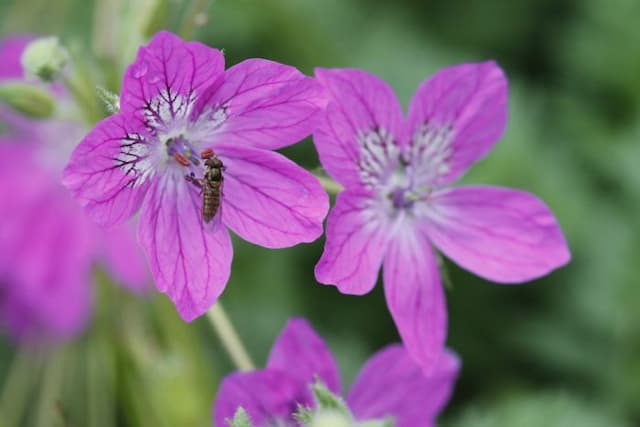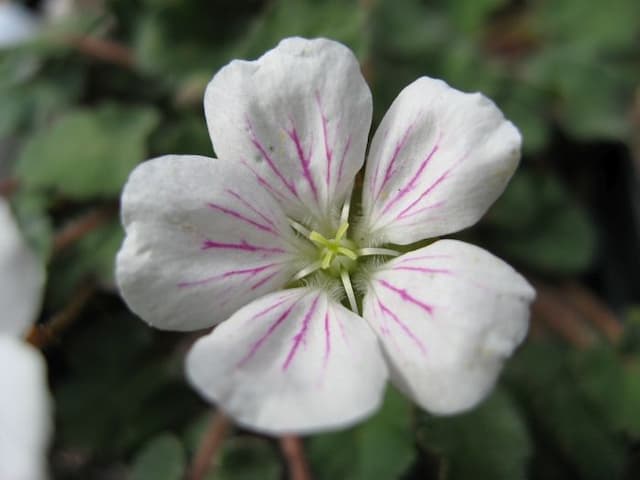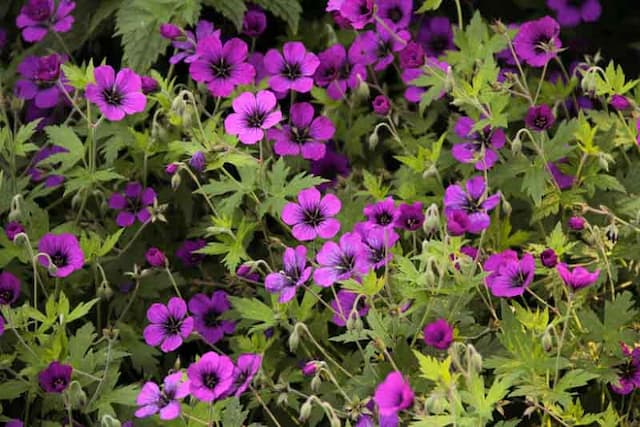Geranium Pelargonium 'Magic Lantern' (Z/c)

ABOUT
Pelargonium 'Magic Lantern' is a striking plant known for its vibrant and variegated foliage along with showy flowers. The leaves are ornately patterned with a blend of green and cream or yellow hues, often with zones or bands that create an eye-catching contrast. During its blooming season, it produces clusters of flowers that are brightly colored, with hues ranging from warm pinks to deep reds, sometimes marked with darker veins or contrasting colors on the petals. The overall form of the plant is bushy and often well-branched, which allows the display of flowers to sit above the decorative foliage, creating a stunning visual impact. This combination of vividly patterned leaves and bold flowers makes Pelargonium 'Magic Lantern' a popular choice for gardeners looking to add a touch of drama to their plant collections.
About this plant
 Names
NamesFamily
Geraniaceae
Synonyms
Geranium, Zonal Geranium, Fish Geranium, Horseshoe Geranium, Pelargonium
Common names
Pelargonium 'Magic Lantern'.
 Toxicity
ToxicityTo humans
The plant commonly known as geranium, specifically the Pelargonium 'Magic Lantern', is generally considered non-toxic to humans. However, ingestion can still potentially cause mild discomfort such as gastrointestinal upset.
To pets
Geraniums, including Pelargonium 'Magic Lantern', are toxic to pets, particularly to dogs and cats. If ingested by a pet, the consequences could include vomiting, anorexia, depression, and dermatitis. In case of ingestion, it is recommended to contact a veterinarian.
 Characteristics
CharacteristicsLife cycle
Perennials
Foliage type
Evergreen
Color of leaves
Mixed
Flower color
Mixed
Height
1-2 feet (30-60 cm)
Spread
1-2 feet (30-60 cm)
Plant type
Herb
Hardiness zones
10
Native area
South Africa
Benefits
 General Benefits
General Benefits- Aesthetic Appeal: Pelargoniums, commonly known as geraniums, add vibrant color and visual interest to gardens and containers with their bright and varied flower hues.
- Easy Maintenance: Geraniums are known for being low-maintenance, requiring minimal care once established, and thus are great for beginner gardeners or those with limited time.
- Drought Tolerance: These plants are quite drought-tolerant, making them suitable for hot, dry climates, and helpful in conserving water.
- Versatility: Geraniums can thrive in a variety of settings, from garden beds to hanging baskets, making them a versatile choice for any gardening design.
- Rapid Growth: They generally grow quickly, providing a speedy display of color and filling in garden spaces efficiently.
- Long Blooming Season: The geranium has a long flowering period, often blooming from spring through to fall, offering long-lasting garden interest.
- Pest Resistance: Geraniums possess natural resistance to some common garden pests, reducing the need for chemical pesticides.
- Attracts Pollinators: While they might not have significant air purifying qualities or medical properties, geraniums can attract beneficial pollinators like bees and butterflies to the garden.
 Medical Properties
Medical PropertiesThis plant is not used for medical purposes.
 Air-purifying Qualities
Air-purifying QualitiesThis plant is not specifically known for air purifying qualities.
 Other Uses
Other Uses- Essential Oil Source: The scented leaves of the geranium can be used to extract essential oil for use in aromatherapy and perfumery.
- Natural Insect Repellant: The plant can act as a natural insect deterrent in the garden, helping to protect other plants from pest damage.
- Crafting and Potpourri: Dried leaves and flowers can be used in crafting or as a fragrant addition to potpourri mixes.
- Edible Flower Garnishes: The flowers of the geranium can be used as an edible decoration on salads, desserts, and fancy drinks.
- Cooling Agent: The crushed leaves can be used topically to provide a cooling effect on the skin, much like aloe vera.
- Botanical Dye: The flowers and leaves can be used to create natural dyes for fabrics or paper crafting.
- Decoration: The vibrant leaves and flowers can be used to create living centerpieces and bouquets.
- Flavoring Agent: Leaves can be used in small quantities to flavor certain foods such as jellies, teas, and baked goods.
- Pet-friendly Plant: Non-toxic to pets, it can safely be grown in homes with pets.
- Cultural Symbolism: In some cultures, geranium plants are used to symbolize unity and togetherness in community events.
Interesting Facts
 Feng Shui
Feng ShuiThe Geranium is not used in Feng Shui practice.
 Zodiac Sign Compitability
Zodiac Sign CompitabilityThe Geranium is not used in astrology practice.
 Plant Symbolism
Plant Symbolism- Transformation - The name 'Magic Lantern' suggests a transformative quality, evoking images of light and magical change.
- Creativity - Pelargoniums, often called 'geraniums', are known for their variety and vibrancy, symbolizing the creative spirit.
- Healing - Geraniums have been used in herbal remedies and represent healing and recovery.
- Friendship - Often found in gardens and shared amongst friends, geraniums are seen as a symbol of friendship and positive relationships.
- Brightness - The bright colors of geranium flowers symbolize cheerfulness and positivity, bringing light to any situation.
 Water
WaterGeraniums like Pelargonium 'Magic Lantern' prefer soil that is evenly moist but not waterlogged. Generally, water your Geranium when the top inch of soil feels dry to the touch, which might be approximately once a week, but the frequency will depend on the climate and indoor conditions. When watering, use room temperature water and add enough so that it starts to run out of the bottom of the pot, indicating the soil is thoroughly moist. Avoid getting water on the leaves to minimize the risk of fungal diseases. On average, using about 8-16 ounces of water every week should be sufficient, but always adjust based on the plant's response and the ambient conditions.
 Light
LightGeraniums require bright, indirect sunlight for optimal growth. Pelargonium 'Magic Lantern' thrives in a location where it can receive about 4-6 hours of filtered sunlight a day. Avoid placing it in direct midday sun, which can scorch the leaves, but ensure it gets plenty of light, such as near a south or west-facing window with a sheer curtain to diffuse the direct sun.
 Temperature
TemperatureGeraniums like Pelargonium 'Magic Lantern' prefer moderate temperatures between 65°F and 75°F during the day and should not be exposed to temperatures below 50°F as they are not frost-tolerant. They can survive short periods of higher temperatures but prolonged exposure to heat above 85°F can stress the plant. The ideal temperature range allows for healthy growth and blooming.
 Pruning
PruningGeraniums, such as Pelargonium 'Magic Lantern', benefit from regular pruning to encourage bushy growth and prevent legginess. Prune in early spring before new growth starts, removing dead or yellowing leaves and any spindly stems. During the growing season, deadhead spent blooms regularly to promote continuous flowering. Pruning can be done every few months to maintain shape and vigor, with the best time being after a flowering cycle has ended.
 Cleaning
CleaningAs needed
 Soil
SoilGeraniums prefer well-draining potting mix with equal parts peat, perlite, and compost. The ideal soil pH for Geranium 'Magic Lantern' should be between 6.0 and 7.0.
 Repotting
RepottingGeraniums should be repotted every 1 to 2 years to refresh the soil and encourage healthy growth. Overgrown plants can be divided during repotting.
 Humidity & Misting
Humidity & MistingGeraniums prefer moderate humidity levels; however, they are quite adaptable to average indoor humidity conditions.
 Suitable locations
Suitable locationsIndoor
Place Geranium 'Magic Lantern' in bright, indirect light indoors.
Outdoor
Outdoors, grow Geranium 'Magic Lantern' in sun to partial shade.
Hardiness zone
9-11 USDA
 Life cycle
Life cycleGeranium 'Magic Lantern' begins its life cycle when its seeds are sown and germinate, a process which typically takes place under warm conditions with moist soil. Once germinated, the seedling stage involves the formation of essential organs like leaves and roots, during which the plant is especially fragile. As it matures into the vegetative stage, the plant grows larger, develops a stronger root system, and produces more foliage, preparing it for the flowering stage. The flowering stage is when the plant exhibits colorful blooms that attract pollinators, essential for the plant's reproduction. After pollination, the plant produces seeds, completing its reproductive cycle. Finally, as a perennial, Geranium 'Magic Lantern' may enter a period of dormancy during colder months, to later resume growth in the following growing season.
 Propogation
PropogationPropogation time
Spring-Early Summer
The Pelargonium 'Magic Lantern', commonly known as Geranium 'Magic Lantern', is best propagated during its active growth period, which is usually in the spring or early summer. The most popular method of propagation for this plant is by stem cuttings. To propagate, take a 4 to 6 inch cutting from a healthy, mature plant, ensuring there are at least three sets of leaves on the cutting. Strip off the bottom set of leaves to expose the nodes and dip the cut end into a rooting hormone. Plant the cutting in well-draining potting mix and keep it moist but not waterlogged. Place the cutting in bright, indirect sunlight and maintain a consistent temperature around 70°F (21°C). Roots should develop within a few weeks, after which the new plants can be transplanted into individual pots.









![Cranesbill [Rothbury Gem]](/_next/image?url=https%3A%2F%2Fplants-admin.emdemapps.com%2Fimages%2Fplants%2F%2Fimages%2F604b6243984c2.png&w=640&q=75)